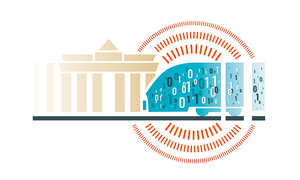November 9, 2021
The Fraunhofer Heinrich Hertz Institute (HHI) is involved in the newly launched research project "BerDiBa" (Berlin Digital Railway Operation) with its departments "Artificial Intelligence" and "Vision & Imaging Technologies". In the project, the 12 partners, coordinated by consortium leader Siemens Mobility, are researching novel technologies for automated rail driving and testing them under real operating conditions. BerDiBa is scheduled to run for four years. It is being funded by the state of Berlin with 7.6 million euros from the ProFIT innovation funding program. The total volume of the BerDiBa project is 13.7 million euros.
Autonomous driving in the automotive industry has been the subject of extensive research for years. Now, researchers are aiming to exploit the potential of automated operations in rail transport as well. The BerDiBa consortium project wants to lay the foundation for this by using innovative technologies to detect obstacles in the track and hazards to passengers on the train on the one hand and monitor changes in the rail infrastructure on the other. In this respect, digital rail operations encompass three aspects: Driverless trains, automatically scheduled maintenance, and the possibility for remote control for situations in which autonomous travel is not possible, for example, due to weather. The basis for this is high-performance sensor systems for perceiving the environment on and in the train. The aim is to make rail traffic safer and processes more efficient.
One key technology in BerDiBa is the powerful and holistic digital replication of rail operations as a so-called digital twin with all necessary status information of trains, train interiors, environment, and infrastructure. Within this context, the change of the operational railroad processes over time poses a unique challenge. Hence, to create a powerful digital twin, past and current data must be continuously integrated, modeled, and analyzed. Accordingly, artificial intelligence (AI) and computer vision (CV) methods play a fundamental role.
"With our expertise in neural network compression, interpretability of AI methods as well as robust object recognition and scene analysis, we can help ensure that the technologies and techniques used are real-time capable, explainable and resilient," explains Wojciech Samek, head of the "Artificial Intelligence" department at Fraunhofer HHI. "These are necessary requirements to realize digital, fully automated real-time control of rail operations using the compiled data."
"We are pleased that the Berlin Senate is funding research into the rail transport of the future in order to make rail travel more efficient, environmentally friendly and safer," says Peter Eisert, head of the "Vision & Imaging Technologies" department at Fraunhofer HHI. "We have already been successfully researching the use of two- and three-dimensional computer vision methods as well as 3D scene analysis in various application areas such as mobility for years. In this project, we can bundle our skills and develop new methods together with our consortium partners and test them right away under real conditions."
Alongside Fraunhofer HHI and Siemens Mobility, Fraunhofer FOKUS, TU Berlin, ITQ, DFKI, DCAITI, Neurocat, Teraki, acs plus, AAI, GSP and Zuse-Institute are also involved in the research project.
